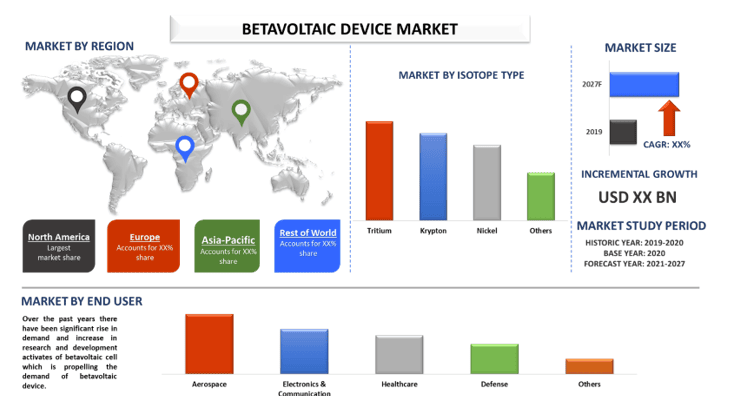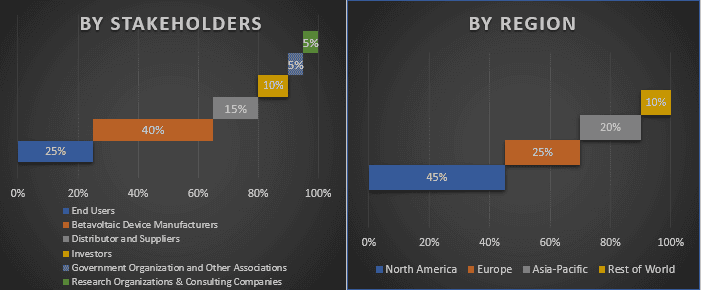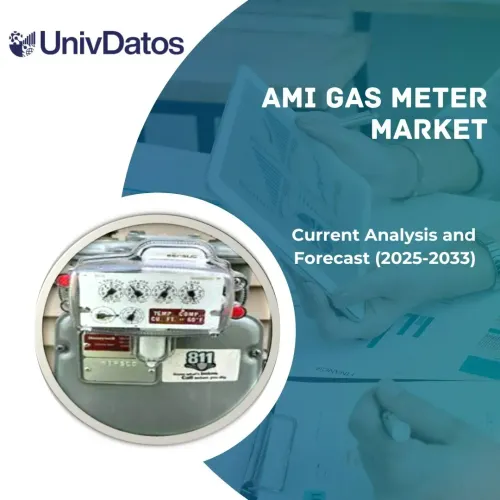Рынок бетавольтаических устройств: текущий анализ и прогноз (2021-2027)
Акцент на типе изотопа (тритий, криптон, никель и другие); конечный потребитель (аэрокосмическая промышленность, электроника и связь, здравоохранение, оборона и другие), а также регион/страна

Ожидается, что к 2027 году объем мирового рынка бетавольтаических устройств достигнет примерно 400 миллионов долларов США, увеличиваясь при умеренном среднегодовом темпе роста более 2% в течение прогнозируемого периода (2021–2027 гг.). На протяжении десятилетий государственная политика поддержки, увеличение инвестиций в исследования и разработки привели к прогрессу в бетавольтаических устройствах, что привело к повышению мирового спроса на бетавольтаические устройства. Кроме того, со временем бетавольтаические устройства стали более надежными, эффективными, с увеличенным сроком службы и высокой производительностью. Поскольку бетавольтаические элементы имеют длительный срок службы, их можно использовать в приложениях, где замена батареи неудобна. Кроме того, аэрокосмическая, оборонная, морская, электронная и коммуникационная отрасли, а также здравоохранение являются основными секторами конечного использования и могут стимулировать рынок значительными темпами. Физический факультет Университета Савитрибай Пхуле Пуна, Индия, разработал ядерные батареи для ISRO, общая стоимость проекта составила около, которые можно использовать для накопления энергии на внешнем конденсаторе в течение короткого или длительного периода; от минут до дней, для работы датчиков.
ЗАПРОСИТЬ БЕСПЛАТНЫЙ ОБРАЗЕЦ В ФОРМАТЕ PDF
Во время пандемии Covid-19 в начале 2020 года в большинстве стран и регионов наблюдалась общенациональная изоляция. Это повлияло на общий спрос на бетавольтаические элементы. Наибольшее снижение наблюдалось в промышленном секторе, где страны ввели закрытие производственных мощностей для снижения распространения Covid-19. Однако ожидается, что спрос на бетавольтаические элементы нормализуется после 2020 года.
Выводы, представленные в отчете
«Среди типов изотопов тритий занимал прибыльную долю рынка в 2020 году».
В зависимости от типа изотопа мировой рынок бетавольтаических устройств подразделяется на тритий, криптон, никель и другие. Среди всех, категория трития занимала прибыльную долю рынка в 2020 году и, как ожидается, сохранит свое значение на рынке в течение прогнозируемого периода. Из-за низкой удельной мощности тритий имеет длительный срок службы, составляющий почти 20 лет. Поскольку тритий излучает электроны низкой энергии, которые можно остановить просто листом бумаги или слоем кожи, что делает его безопасным и подходящим выбором для бетавольтаических элементов. Поскольку никель в основном присутствует только в России, наличие высоких гамма-лучей и низкого потока из-за присутствующих примесей делает никель непригодным для использования в бетавольтаических устройствах. Хотя бетавольтаическое устройство на основе никеля служит более 100 лет. Следовательно, с увеличением инвестиций в исследования и разработки спрос на бетавольтаические устройства на основе никеля, вероятно, увеличится в течение прогнозируемого периода.
«Среди конечных пользователей сектор здравоохранения занимал значительную долю рынка в 2020 году».
В зависимости от конечного пользователя сегмент подразделяется на аэрокосмическую промышленность, электронику и связь, здравоохранение, оборону и другие (нефть и газ, морской транспорт). Среди всех, сектор здравоохранения занимает значительную долю рынка бетавольтаических устройств из-за роста числа сердечно-сосудистых заболеваний и использования бетавольтаических элементов при производстве кардиостимуляторов. Кроме того, бетавольтаические элементы используются в основных приложениях в медицинских имплантатах, где поддерживаются биологические функции, такие как сердцебиение. Кроме того, без какого-либо хирургического вмешательства бетавольтаические элементы могут служить источником питания для имплантируемых медицинских устройств, таких как кардиостимуляторы и имплантируемые кардиодефибрилляторы, в течение более 10 лет. Например, в 2018 году около 42% смертей в США были вызваны сердечно-сосудистыми заболеваниями.
«Северная Америка представляет собой значительный рынок на мировом рынке бетавольтаических устройств».
Для лучшего понимания внедрения на рынке в отчете представлен подробный анализ основных регионов и стран, включая Северную Америку (США, Канада, остальная часть Северной Америки), Европу (Германия, Великобритания, Россия, Франция, Испания, остальная часть Европы), Азиатско-Тихоокеанский регион (Китай, Япония, Индия, Австралия, остальная часть АТР) и остальной мир. Северная Америка занимала значительную долю рынка, и ожидается, что она увидит высокий рост бетавольтаических устройств благодаря тому, что производственные компании уделяют внимание рынку, увеличивая инвестиции в исследования и разработки в сочетании с благоприятной государственной политикой. Некоторые из основных игроков, работающих на рынке, включают City Labs Inc., BetaBatt, Inc., Direct Kinetic Solutions, Widetronix, Qynergy Corp.
Причины купить этот отчет:
- Исследование включает в себя анализ размеров рынка и прогнозирование, подтвержденный проверенными ключевыми экспертами отрасли
- Отчет представляет собой краткий обзор общей производительности отрасли с первого взгляда
- Отчет охватывает углубленный анализ видных участников отрасли с уделением особого внимания ключевым финансовым показателям бизнеса, портфелю продуктов, стратегиям расширения и последним разработкам
- Подробное изучение драйверов, ограничений, ключевых тенденций и возможностей, преобладающих в отрасли
- Исследование всесторонне охватывает рынок по различным сегментам
- Глубокий анализ отрасли на уровне страны
Варианты настройки:
Мировой рынок бетавольтаических устройств может быть дополнительно настроен в соответствии с требованиями или любым другим сегментом рынка. Кроме того, UMI понимает, что у вас могут быть свои собственные бизнес-потребности, поэтому не стесняйтесь обращаться к нам, чтобы получить отчет, который полностью соответствует вашим требованиям.
Содержание
Анализ исторического рынка, оценка текущего рынка и прогнозирование будущего рынка бетавольтаических устройств были тремя основными этапами, предпринятыми для создания и анализа их внедрения по всему миру. Было проведено исчерпывающее вторичное исследование для сбора исторических рыночных показателей и оценки текущего размера рынка. Во-вторых, для подтверждения этих выводов было принято во внимание множество результатов и предположений. Кроме того, были проведены исчерпывающие первичные интервью с отраслевыми экспертами по всей цепочке создания стоимости индустрии бетавольтаических элементов. После предположения и подтверждения рыночных показателей посредством первичных интервью мы использовали восходящий подход для прогнозирования полного размера рынка. Впоследствии были приняты методы разбивки рынка и триангуляции данных для оценки и анализа размера рынка сегментов и подсегментов, к которым относится отрасль. Подробная методология описана ниже:
Анализ исторического размера рынка
Шаг 1: Углубленное изучение вторичных источников:
Было проведено детальное вторичное исследование для получения исторических данных о размере рынка бетавольтаических устройств из внутренних источников компании, таких как годовые отчеты и финансовая отчетность, презентации о производительности, пресс-релизы и т. д., и внешних источников, включая журналы, новости и статьи, правительственные публикации, публикации конкурентов, отраслевые отчеты, сторонние базы данных и другие достоверные публикации.
Шаг 2: Сегментация рынка:
После получения исторических данных о размере рынка бетавольтаических устройств мы провели детальный вторичный анализ для сбора текущей рыночной информации и доли для различных сегментов и подсегментов для основных регионов. Основные сегменты, включенные в отчет, включают тип изотопа и конечного пользователя. Был проведен дальнейший анализ на региональном и страновом уровнях для оценки общего внедрения бетавольтаических устройств в глобальном масштабе.
Шаг 3: Факторный анализ:
После получения исторических данных о размере рынка различных сегментов и подсегментов мы провели детальный факторный анализ для оценки текущего размера рынка бетавольтаических устройств. Кроме того, мы провели факторный анализ с использованием зависимых и независимых переменных, таких как растущий сектор здравоохранения и увеличение деятельности в области НИОКР, связанной с бетавольтаическими элементами. Был проведен тщательный анализ сценария спроса и предложения с учетом ведущих партнерств, слияний и поглощений, расширения бизнеса и запуска продуктов в индустрии бетавольтаических устройств.
Оценка и прогноз текущего размера рынка
Определение текущего размера рынка: Основываясь на действенных выводах, полученных на основе вышеуказанных 3 шагов, мы определили текущий размер рынка, ключевых игроков на мировом рынке бетавольтаических устройств и доли рынка каждого сегмента. Все необходимые процентные доли, разделения и разбивки рынка были определены с использованием вышеупомянутого вторичного подхода и проверены посредством первичных интервью.
Оценка и прогнозирование: Для оценки и прогнозирования рынка различным факторам были присвоены веса, включая драйверы и тенденции, ограничения и возможности, доступные для заинтересованных сторон. После анализа этих факторов были применены соответствующие методы прогнозирования, т.е. восходящий подход, чтобы получить прогноз рынка до 2027 года для различных сегментов и подсегментов в основных регионах мира. Методология исследования, принятая для оценки размера рынка, включает в себя:
- Размер рынка отрасли в стоимостном выражении (доллары США) и темпы внедрения бетавольтаических устройств на основных рынках
- Все процентные доли, разделения и разбивки рыночных сегментов и подсегментов
- Ключевые игроки в области бетавольтаических устройств с точки зрения предлагаемых услуг. Кроме того, стратегии роста, принятые этими игроками для конкуренции на быстрорастущем рынке.
Подтверждение размера и доли рынка
Первичное исследование: Были проведены углубленные интервью с ключевыми лидерами мнений (KOL), включая руководителей высшего звена (CXO/вице-президенты, руководители отдела продаж, руководители отдела маркетинга, руководители операционного отдела и региональные руководители, руководители страны и т. д.) в основных регионах. Затем результаты первичного исследования были обобщены и проведен статистический анализ для доказательства заявленной гипотезы. Вклад первичного исследования был объединен с результатами вторичного исследования, что превратило информацию в полезные сведения.
Разбивка основных участников первичного исследования по разным регионам

Инжиниринг рынка
Для завершения общей оценки рынка и получения точных статистических данных по каждому сегменту и подсегменту мирового рынка бетавольтаических устройств была применена техника триангуляции данных. Данные были разделены на несколько сегментов и подсегментов после изучения различных параметров и тенденций в областях типа изотопа и конечного пользователя.
Основная цель исследования рынка бетавольтаических устройств
В исследовании были точно определены текущие и будущие рыночные тенденции глобальных бетавольтаических устройств. Инвесторы могут получить стратегические сведения, чтобы основывать свои решения для инвестиций на качественном и количественном анализе, выполненном в исследовании. Текущие и будущие рыночные тенденции будут определять общую привлекательность рынка на уровне страны, предоставляя промышленному участнику платформу для освоения неиспользованного рынка, чтобы получить выгоду от преимущества первопроходца. Другие количественные цели исследований включают:
- Проанализировать текущий и прогнозируемый размер рынка бетавольтаических устройств в стоимостном выражении (доллары США). Кроме того, проанализировать текущий и прогнозируемый размер рынка различных сегментов и подсегментов
- Сегменты в исследовании включают области типа изотопа и конечного пользователя
- Определенный анализ нормативно-правовой базы для индустрии бетавольтаических устройств
- Проанализировать цепочку создания стоимости с участием различных посредников, а также проанализировать поведение клиентов и конкурентов в отрасли
- Проанализировать текущий и прогнозируемый размер рынка бетавольтаических устройств для основных стран
- Основные регионы/страны, проанализированные в отчете, включают Северную Америку (США, Канада, остальная часть Северной Америки), Европу (Германия, Великобритания, Франция, Испания, остальная часть Европы), Азиатско-Тихоокеанский регион (Китай, Япония, Индия, Австралия, остальная часть Азиатско-Тихоокеанского региона) и остальной мир.
- Профили компаний-игроков рынка бетавольтаических устройств и стратегии роста, принятые ими для поддержания устойчивости на быстрорастущем рынке
Углубленный анализ отрасли на уровне страны
Связанные Отчеты
Клиенты, купившие этот товар, также купили










